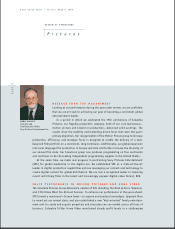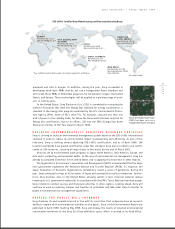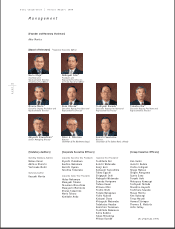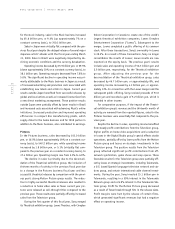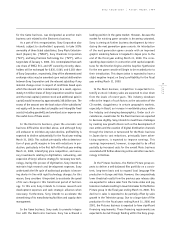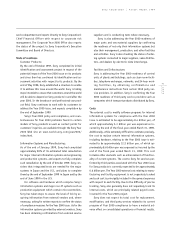Sony 1999 Annual Report Download - page 33
Download and view the complete annual report
Please find page 33 of the 1999 Sony annual report below. You can navigate through the pages in the report by either clicking on the pages listed below, or by using the keyword search tool below to find specific information within the annual report.
Sony Corporation Annual Report 1999
31
page
operating activities was partially offset by a decrease in
notes and accounts payable and a decrease in net income,
which also included a 58.7 billion yen (pre-tax) non-cash
item representing the aforementioned gain on securities
contribution to employee retirement benefit trust. Depre-
ciation and amortization increased by 5.5 billion yen, or
1.8%, to 307.2 billion yen. This comprises depreciation of
fixed assets of 267.5 billion yen, amortization of intangible
assets of 19.0 billion yen, and amortization of deferred in-
surance acquisition costs of 20.7 billion yen.
Net cash used in investing activities during the fiscal
year ended March 31, 1999 decreased by 231.4 billion
yen, or 38.7%, to 367.3 billion yen. This decrease was
principally attributable to a decrease in marketable se-
curities of Sony Corporation and time deposits, along with
proceeds from the merger of Loews Theatres with Cineplex
Odeon Corporation.
Payments for purchases of fixed assets during the year
decreased by 9.7 billion yen, or 2.6%, to 368.4 billion yen.
Capital expenditures (additions to fixed assets) decreased
34.2 billion yen, or 8.8%, to 353.7 billion yen. In the Elec-
tronics business, capital expenditures aggregated 252.4 bil-
lion yen, principally in the areas of semiconductors, displays,
and recording media. Capital expenditures for the Music busi-
ness amounted to 45.2 billion yen, principally for offices
and plants in Japan. Capital expenditures for the fiscal year
ending March 31, 2000 are expected to amount to approxi-
mately 430 billion yen. These expenditures include approxi-
mately 100 billion yen in connection with the next
generation game console and an aggregate of approximately
240 billion yen in the Electronics business.
Increase in payments for investments and advances and
increase in proceeds from sales of investment securities and
collection of advances are principally attributable to an active
rebalancing of the portfolio in the Insurance business due
to volatile bond market conditions in Japan during the year.
Payments for investments and advances include the afore-
mentioned investments in GI, Telemundo, and ST-LCD in
the aggregated amount of 53.5 billion yen.
Net cash used in financing activities during the fiscal
year ended March 31, 1999 increased by 94.5 billion yen, or
532%, to 112.2 billion yen at March 31,1999. The increase
was principally attributable to the increase in redemption
of short-term debt and the decrease in long-term debt.
RESULTS OF OPERATIONS
(The fiscal year ended March 31, 1999 compared to the
fiscal year ended March 31, 1998)
The general economic and operating environment further
worsened toward the end of the fiscal year ended March
31, 1999, reflecting factors which included economic weak-
ness in Asia excluding Japan (“Asia”), Russia and Eastern
Europe, and Latin America, as well as a rapid appreciation
in the value of the yen in the second half of the year.
Under these circumstances, Sony’s consolidated sales and
operating revenue (“sales”) increased by only 0.6%, and
operating income decreased by 34.9%. The low growth rate
of sales was primarily attributable to declines in sales in
the Electronics and Pictures businesses. On the other hand,
sales in the Game, Music, Insurance, and Other businesses
increased. The large decrease in operating income was pri-
marily attributable to a substantial decline in profitability
in the Electronics business. Operating income in the
Electronics business declined sharply due to increases in
cost of sales and selling, general and administrative
expenses as well as the decrease in sales. Also, operating
income in the Music and Insurance businesses decreased,
while the Other business has posted operating losses for
the second consecutive year. However, the Game business
maintained positive momentum principally outside Japan.
In the Pictures business, operating income also increased.
Impact of Foreign Exchange Fluctuations and Basic
Countermeasures
During the year, sales outside Japan accounted for approxi-
mately 72% of Sony’s consolidated sales. Although the value
of the yen against foreign currencies began rising sharply
in October 1998, the average value of the yen depreciated
4.1%, 4.8%, and 5.8% against the U.S. dollar, British pound,
and German marks, respectively, during the year (i.e., 127.0
yen, 207.7 yen, and 72.8 yen against the U.S. dollar, Brit-
ish pound, and German marks, respectively). This decline in
the average value of the yen positively impacted the re-
ported financial results translated into the yen. It is esti-
mated that sales and operating income would have declined
by approximately 2% and 49%, respectively, compared with
the previous fiscal year if the value of the yen had remained
the same as in the previous fiscal year. (Note that these



